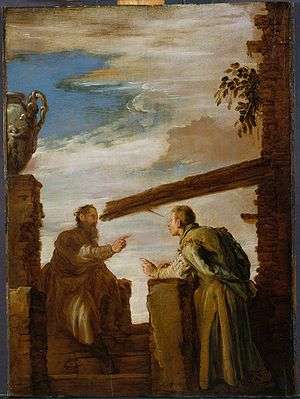Matthew 7:3

Matthew 7:3 is the third verse of the seventh chapter of the Gospel of Matthew in the New Testament and is part of the Sermon on the Mount. This verse continues the discussion of judgmentalism.
In the King James Version of the Bible the text reads:
- And why beholdest thou the mote that is in thy brother's eye,
- but considerest not the beam that is in thine own eye?
The World English Bible translates the passage as:
- Why do you see the speck that is in your brother’s eye,
- but don’t consider the beam that is in your own eye?
For a collection of other versions see Bible Hub Matthew 7:3
The meaning of this verse is fairly clear, it is an attack on the hypocrites who attack others for their small flaws, while ignoring their own massive ones. Those who judge others, but do not evaluate themselves. It has a dual meaning, first attacking the hypocrisy of those who criticize others while ignoring their own much larger flaws, and since the flaw is in the eye it is a metaphor for how such flaws can blind one.
The metaphor is a rather extreme one. The word translated as mote or speck can refer to a tiny splinter or piece of sawdust, or colloquially to any minute object. The word translated as beam refers to a log or a rafter such as would hold up the roof of a house. A rafter is a difficult thing to get in one's eye, but it functions as a humorous and hyperbolic metaphor for an extreme flaw. The metaphor comes from woodworking, and is often seen as rooted in Jesus' traditional employment as a carpenter.
References
- Fowler, Harold. The Gospel of Matthew: Volume One. Joplin: College Press, 1968
- Schweizer, Eduard. The Good News According to Matthew. Atlanta: John Knox Press, 1975
| Preceded by Matthew 7:2 |
Gospel of Matthew Chapter 7 |
Succeeded by Matthew 7:4 |